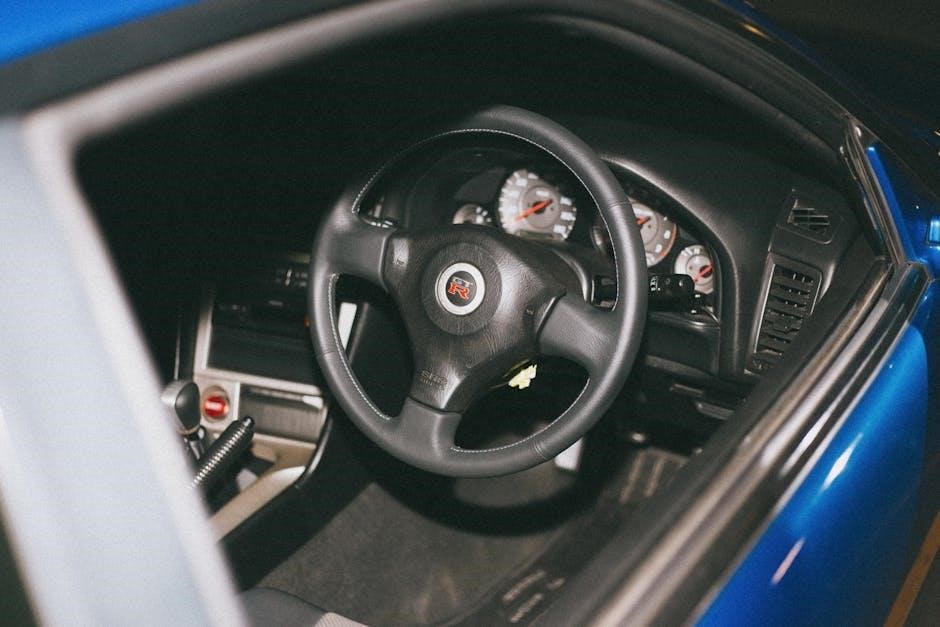The “See Owner’s Manual” message in Nissan Kicks often indicates system malfunctions, such as CVT issues, sensor problems, or dashboard warnings. This guide helps owners understand and address these issues effectively.
1.1 Overview of Common Malfunctions in Nissan Kicks
Nissan Kicks owners often encounter issues like sudden loss of acceleration, jerking movements, and error messages such as “System Malfunction: See Owner’s Manual.” These problems can stem from faulty sensors, CVT transmission issues, or dirty radar/sonar systems. Acceleration-related malfunctions may cause the vehicle to stall or hesitate, while error messages often indicate system failures. Cleaning sensors or restarting the vehicle can sometimes resolve these issues. Regular maintenance and prompt repairs are essential to prevent recurring problems and ensure safe driving conditions. Understanding these common malfunctions helps owners address them effectively and maintain their vehicle’s performance.
1.2 Importance of the Owner’s Manual in Diagnosing Issues
The Nissan Kicks Owner’s Manual is a vital resource for diagnosing malfunctions. It provides detailed explanations of warning lights, error messages, and system checks. By referencing the manual, owners can identify potential causes of issues like “System Malfunction” or “No Key Detected” errors. It also offers guidance on resetting systems, such as the sonar and radar, and recommends when to visit a dealer. The manual’s maintenance tips help prevent issues and ensure optimal vehicle performance. It serves as a comprehensive guide, empowering owners to address problems confidently and efficiently, reducing the need for guesswork or unnecessary repairs.
Understanding the “Malfunction: See Owner’s Manual” Message
The “Malfunction: See Owner’s Manual” message indicates a system issue requiring attention. It often relates to error codes or sensor problems, directing owners to consult the manual for specific solutions and troubleshooting steps to resolve the issue effectively.
2.1 What the Message Indicates
The “Malfunction: See Owner’s Manual” message signals a system malfunction detected by the vehicle’s onboard computer. It typically points to issues like faulty sensors, software glitches, or mechanical failures. This alert prompts the driver to consult the owner’s manual for guidance on identifying the specific problem. Common triggers include dirty radar sensors, CVT transmission issues, or error codes stored in the vehicle’s system. The message serves as a prompt for the owner to take corrective action, such as cleaning sensors, resetting systems, or seeking professional assistance if the issue persists.
2.2 Common Scenarios When the Message Appears
The “Malfunction: See Owner’s Manual” message often appears during specific driving conditions or system malfunctions. Common triggers include sudden acceleration issues, where the vehicle hesitates or stalls. Drivers may also encounter this message when the CVT transmission experiences problems, such as slipping or unusual revving. Additionally, faulty sensors, like the front-end crash detection system, can activate this alert when they become dirty or malfunction. In some cases, the message may display after a system reset or software update. Understanding these scenarios helps owners identify potential causes and take appropriate steps to resolve the issue promptly.
2.3 Immediate Steps to Take When the Message Displays
When the “Malfunction: See Owner’s Manual” message appears, it is crucial to take immediate action to ensure safety and prevent further issues. First, safely pull over and turn off the engine. Allow the vehicle to rest for at least 10 minutes to reset the system. Restart the engine and check if the message persists. If the issue remains, inspect the sonar and radar sensors for dirt or obstructions, as they often trigger false warnings. Consult the owner’s manual for specific guidance, and if problems continue, visit a certified Nissan service center for professional diagnosis and repairs. Prompt action helps minimize potential damage and ensures optimal vehicle performance.
Malfunction Indicator Light (MIL) and Dashboard Warnings
The Malfunction Indicator Light (MIL) and dashboard warnings in Nissan Kicks signal various system issues, such as engine problems or sensor malfunctions, prompting owners to check the owner’s manual for guidance and solutions.
3.1 What is the Malfunction Indicator Light (MIL)?
The Malfunction Indicator Light (MIL) in Nissan Kicks is a dashboard warning light that illuminates when the vehicle’s onboard computer detects a system malfunction. It can appear as a yellow or orange light, often shaped like an engine or with the words “CHECK ENGINE.” The MIL serves as a critical alert system, indicating issues ranging from minor problems, such as loose gas caps, to serious engine or emissions-related malfunctions. When the MIL lights up, it prompts the driver to consult the owner’s manual or visit a certified Nissan service center for diagnostics and repairs to ensure the vehicle operates safely and efficiently.
3.2 How to Identify Different Dashboard Warning Lights
Nissan Kicks dashboard warning lights vary in color and symbol to indicate specific issues. The owner’s manual provides a detailed guide with pictures and explanations for each light. Common lights include the master warning light, which illuminates when multiple systems are affected, and the front end crash detection symbol, often a car hitting a triangle. Yellow or orange lights typically signal system malfunctions, while red lights indicate serious issues requiring immediate attention. Referencing the manual helps owners quickly identify and address problems, ensuring safety and proper vehicle maintenance.
3;3 The Role of the Master Warning Light
The master warning light in Nissan Kicks serves as a general alert for multiple system issues. Typically yellow or orange, it illuminates when various malfunctions occur, such as sensor problems or system errors. This light is distinct from the MIL and often prompts owners to consult the owner’s manual for specific guidance. Its purpose is to notify drivers of potential issues that may require immediate attention or routine maintenance. When the master warning light appears, it is essential to review the manual or visit a Nissan dealer to address the underlying cause and ensure vehicle safety.

Acceleration and Performance-Related Malfunctions
Acceleration and performance issues in Nissan Kicks, such as hesitation or stalling, often relate to CVT problems or sensor malfunctions. Check the owner’s manual for guidance.
4.1 Sudden Loss of Acceleration: Causes and Solutions
Sudden loss of acceleration in Nissan Kicks can occur due to CVT malfunction, dirty sensors, or faulty accelerator components. Cleaning sensors and checking for error codes often resolve the issue. If the problem persists, consulting the owner’s manual or visiting a Nissan dealer is recommended to avoid further damage.
4.2 Jerking or Stalling Movements: Possible Causes
Jerking or stalling in Nissan Kicks can be caused by issues with the CVT transmission or faulty sensors. Dirty or malfunctioning sensors may disrupt acceleration signals, leading to uneven performance. Additionally, software glitches or low transmission fluid levels can contribute to stalling. Cleaning sensors, restarting the system, or checking for error codes often resolves the issue. If problems persist, consulting the owner’s manual or visiting a Nissan dealer is recommended to ensure proper diagnosis and repair, preventing further damage to the vehicle’s transmission or engine systems.
4.3 Engine Revving Issues: Diagnostic Tips
Engine revving issues in Nissan Kicks may stem from CVT malfunctions or throttle sensor problems. Check for error codes using an OBD-II scanner to identify specific faults. Cleaning or replacing faulty sensors, ensuring proper transmission fluid levels, and resetting the system can often resolve the issue. If revving persists, consult the owner’s manual for guidance or visit a Nissan specialist to prevent further damage and ensure optimal performance. Regular maintenance and prompt repairs are crucial to maintaining the vehicle’s reliability and efficiency on the road.

Error Messages and Their Meanings
Understanding error messages like “System Malfunction” or “No Key Detected” is crucial for diagnosing issues in your Nissan Kicks. Referencing the owner’s manual provides clear explanations and solutions for these alerts, helping you address problems effectively and maintain your vehicle’s performance.
5.1 “System Malfunction: See Owner’s Manual”
The “System Malfunction: See Owner’s Manual” message in your Nissan Kicks indicates a detected issue within the vehicle’s systems. This could range from minor sensor malfunctions to more serious problems like CVT transmission issues. The owner’s manual provides detailed explanations and troubleshooting steps for such errors. Common causes include dirty or faulty sensors, software glitches, or system communication errors. It is essential to refer to the manual to identify the specific issue and determine the appropriate course of action, whether it be a simple fix or a visit to a certified mechanic.
5.2 “No Key Detected” Error in Nissan Kicks
The “No Key Detected” error in Nissan Kicks typically occurs when the vehicle’s keyless entry system fails to recognize the key fob. This can happen due to a weak battery in the fob, interference from other electronic devices, or a malfunction in the vehicle’s proximity sensors. To resolve this, ensure the key is present, check the fob’s battery, and clean the sensors. If the issue persists, consult the owner’s manual for troubleshooting steps or visit a Nissan service center for assistance. This error is often related to the vehicle’s keyless entry system and requires prompt attention to maintain functionality.
5.3 “Front End Crash Detection” Warning
The “Front End Crash Detection” warning in Nissan Kicks is triggered when the vehicle’s sensors detect a potential collision. This system is part of the advanced driver-assistance features, designed to alert the driver and prepare safety measures. However, this warning can also activate due to dirty or obstructed sensors, often caused by dirt, snow, or debris on the front grille or radar sensors. To resolve this, clean the sensors thoroughly and restart the vehicle. If the issue persists, consult the owner’s manual or visit a Nissan service center to ensure proper functionality and safety system reliability.

Nissan Kicks Model-Specific Issues
Different Nissan Kicks model years experience unique malfunctions. The 2021 model often faces acceleration issues, while the 2024 may encounter CVT problems, and the 2019 might have sonar system glitches.
6.1 Common Problems in 2021 Nissan Kicks
The 2021 Nissan Kicks has reported issues with acceleration malfunctions, often displaying the “See Owner’s Manual” message. Owners have experienced sudden loss of power while driving, which can be alarming. Some users have noted that this issue arises unexpectedly, with the vehicle failing to respond to throttle input. Additionally, there have been instances of the dashboard warning lights illuminating, particularly the Master Warning Light, indicating system malfunctions. These problems are frequently linked to sensor or software glitches. It is crucial for owners to refer to the owner’s manual for initial troubleshooting steps and to visit a Nissan dealership for professional diagnosis and repairs. Regular maintenance and updating the vehicle’s software can help mitigate these issues, ensuring a safer and smoother driving experience.
6.2 Recurring Issues in 2024 Nissan Kicks
The 2024 Nissan Kicks has faced recurring issues, including the “System Malfunction: See Owner’s Manual” message, often linked to the CVT system or sensor problems. Some owners have reported intermittent acceleration hitches and error messages like “No Key Detected” or “Front End Crash Detection.” These issues frequently appear due to dirty or malfunctioning sonar and radar sensors, which can trigger false warnings. Cleaning the sensors and resetting the system often resolve these problems. However, persistent issues may require professional diagnosis. Consulting the owner’s manual and visiting a Nissan dealership are recommended for accurate troubleshooting and repairs, ensuring optimal performance and safety. Regular maintenance, such as CVT fluid checks, can help prevent these malfunctions. Staying informed about software updates and adhering to maintenance schedules is essential for long-term reliability.
6.3 Known Malfunctions in 2019 Nissan Kicks
The 2019 Nissan Kicks has experienced several known malfunctions, including the “Malfunction: See Owner’s Manual” message, often related to the CVT system and sensor issues. Owners have reported jerking or stalling movements, particularly during acceleration, which may indicate problems with the transmission or faulty sensors. Additionally, some drivers have encountered the “Front End Crash Detection” warning, frequently caused by dirty or obstructed sensors. Cleaning the sensors and restarting the system often resolve these issues. However, persistent problems may require professional attention. Regular maintenance, such as checking CVT fluid levels and ensuring sensor cleanliness, can help prevent these malfunctions. Consulting the owner’s manual and visiting a Nissan dealership for repairs are strongly recommended to maintain vehicle performance and safety. Staying informed about potential issues and adhering to maintenance schedules is crucial for long-term reliability and driver satisfaction.

CVT Transmission and Malfunction Issues
The CVT transmission in Nissan Kicks can malfunction due to fluid degradation or sensor issues, causing slipping gears or erratic acceleration. Regular fluid replacement and checks are essential to prevent such problems and ensure smooth performance. Owners should refer to the manual for maintenance schedules and diagnostic tips to address CVT-related warnings promptly. DIY maintenance, like monitoring fluid levels, can also help prevent malfunctions. Consulting a professional is recommended for persistent issues to avoid further damage. Proper care extends the transmission’s lifespan and maintains vehicle reliability. Always follow guidelines to ensure optimal performance and safety on the road.
7.1 CVT Fluid Replacement and Its Importance
CVT fluid replacement is crucial for maintaining the health of your Nissan Kicks’ transmission. Over time, the fluid can degrade, leading to slipping gears, erratic acceleration, and potentially costly repairs. The owner’s manual recommends replacing the CVT fluid every 30,000 to 60,000 miles, depending on driving conditions. Contaminated fluid can cause malfunctions, triggering warning messages like “System Malfunction: See Owner’s Manual.” Using the correct type of fluid is essential, as specified in the manual. Regular fluid changes help prevent premature wear and ensure smooth transmission operation. Neglecting this maintenance can lead to severe transmission damage, requiring expensive rebuilds or replacements. Always consult a Nissan specialist if you notice signs of CVT malfunction to avoid further complications.
7.2 Symptoms of CVT Malfunction in Nissan Kicks
Common symptoms of CVT malfunction in Nissan Kicks include sudden loss of acceleration, jerking or stalling movements, and unusual noises like grinding or whining. Drivers may also notice hesitation when shifting gears or erratic RPM fluctuations on the tachometer. In some cases, the “Malfunction: See Owner’s Manual” message appears, indicating a potential issue with the transmission system. These symptoms often point to worn-out components, low or contaminated CVT fluid, or sensor malfunctions. Addressing these issues promptly is crucial to prevent further damage to the transmission and ensure smooth vehicle operation. Consulting the owner’s manual or a certified technician is recommended for accurate diagnosis and repair.
7.3 DIY Tips for CVT Maintenance
Regular CVT fluid checks and replacements are essential to maintain smooth transmission performance. Use only Nissan-approved CVT fluid to ensure compatibility and optimal function. Clean the CVT sensors and connectors to prevent faulty readings. Monitor for signs of wear, such as unusual noises or hesitation, and address them early. DIY enthusiasts can reset the CVT system after minor repairs using an OBD-II scanner. Always consult the owner’s manual for specific guidelines and recommendations. Proper maintenance can extend the life of your CVT and prevent costly repairs down the road.

Sonar and Radar System Malfunctions
Sonar and radar system malfunctions in Nissan Kicks often occur due to dirty sensors or software glitches. Cleaning the sensors and restarting the system can resolve many issues.
8.1 Cleaning Sonar and Radar Sensors
Cleaning the sonar and radar sensors on your Nissan Kicks is crucial for maintaining proper functionality. These sensors, often located on the front grille and rear bumper, can become dirty or obstructed, leading to false warnings or system malfunctions. Use a soft cloth and mild water to wipe away dirt, dust, or debris. Avoid harsh chemicals or abrasive materials that could damage the sensors. After cleaning, turn off the vehicle for a few minutes and restart the engine to reset the system. Regular maintenance ensures accurate sensor performance and prevents unnecessary “See Owner’s Manual” alerts.
8.2 How Dirty Sensors Trigger Warning Messages
Dirty sonar and radar sensors on the Nissan Kicks can trigger warning messages like “Malfunction: See Owner’s Manual.” Dust, dirt, or debris obstructing these sensors disrupts their ability to detect surroundings accurately. This interference can cause the system to malfunction, leading to false alerts or deactivation of safety features. For example, a dirty front sonar sensor may activate the front end crash detection warning. Regular cleaning ensures proper sensor function and prevents unnecessary warnings. Always refer to the owner’s manual for guidance on maintaining these critical systems and resolving related issues promptly. Clean sensors are essential for reliable vehicle performance and safety.
8;3 Resetting the Sonar System
Resetting the sonar system in your Nissan Kicks can often resolve malfunction issues. Begin by cleaning the sensors, located on the front grille and rear areas, to ensure proper detection. Turn the vehicle off, wait a few minutes, and restart the engine to reset the system. If the issue persists, consult the owner’s manual for specific instructions or visit a Nissan dealer. Regular maintenance and sensor cleaning can prevent future malfunctions, ensuring optimal performance and safety. This simple process helps restore functionality to your vehicle’s advanced driver-assistance systems.

The Role of the Owner’s Manual in Troubleshooting
The owner’s manual provides essential troubleshooting guidance, offering step-by-step solutions for malfunctions, explaining error codes, and outlining maintenance tips to prevent future issues.
9.1 Navigating the Owner’s Manual for Malfunction Solutions
The owner’s manual is a comprehensive resource for addressing malfunctions in the Nissan Kicks. It is organized into sections that help users quickly identify and resolve issues. The manual typically includes a table of contents and an index, allowing owners to search for specific topics or error messages; Detailed explanations of warning lights, such as the “Malfunction: See Owner’s Manual” message, are provided along with recommended actions. Additionally, maintenance schedules and troubleshooting guides are included to help prevent and fix common problems. Regularly referring to the manual ensures optimal vehicle performance and safety.
9.2 Key Sections to Refer to for Common Issues
The owner’s manual for the Nissan Kicks includes dedicated sections for diagnosing and addressing common malfunctions. Key areas to review include the “Dashboard Warning Lights” section, which explains the meaning of indicators like the Malfunction Indicator Light (MIL) and master warning light. The “Error Messages” section provides interpretations of alerts such as “System Malfunction: See Owner’s Manual.” Additionally, the manual outlines maintenance schedules and troubleshooting guides for issues like CVT malfunctions or sensor-related problems. By focusing on these sections, owners can quickly identify and resolve common issues, ensuring their vehicle operates smoothly and safely.
9.3 Maintenance Tips from the Owner’s Manual
The Nissan Kicks owner’s manual provides essential maintenance tips to prevent malfunctions. Regular checks of the CVT fluid level and condition are crucial, as low or degraded fluid can lead to transmission issues. Cleaning the sonar and radar sensors, especially after washing the car or in harsh weather, ensures proper functionality of safety features. The manual also recommends periodic inspections of dashboard warning lights to address potential problems early; By following these guidelines, owners can minimize the risk of system malfunctions and ensure optimal vehicle performance. Routine maintenance is key to extending the lifespan of your Nissan Kicks.
Diagnostic Tools and OBD-II Scanners
Nissan Kicks owners can use OBD-II scanners to identify error codes, such as those related to the “See Owner’s Manual” message, aiding in quick issue resolution.
10.1 Using an OBD-II Scanner to Identify Issues
An OBD-II scanner connects to your Nissan Kicks’ onboard computer, retrieving specific error codes that explain the “See Owner’s Manual” message. This tool provides detailed insights into system malfunctions, such as faulty sensors or transmission issues. By reading these codes, you can pinpoint the exact problem, whether it’s related to the CVT, engine performance, or safety features like front-end crash detection. Many scanners also offer real-time data monitoring, helping you track your car’s health and address issues before they escalate. Regular use of an OBD-II scanner can save time and money by diagnosing problems early.
10.2 Common Error Codes in Nissan Kicks
Nissan Kicks owners frequently encounter error codes related to CVT issues, such as P0171 (system too lean) or P0705 (transmission range sensor failure). These codes often appear alongside the “See Owner’s Manual” message, indicating malfunctions like low transmission fluid levels or faulty sensors. Other common codes include P0011 (camshaft position sensor issues) and P0507 (idle air control system malfunctions). These codes help owners and technicians identify specific problems, such as sensor cleanliness or software updates needed. Regularly referencing the owner’s manual or a Nissan dealer can help resolve these issues promptly and prevent further damage to the vehicle.
10.3 Resetting Error Codes After Repairs
After resolving the issue, error codes in your Nissan Kicks can be reset using an OBD-II scanner or by disconnecting the battery. Turn the ignition to “ON” and clear the codes via the scanner. If equipped, some systems may reset automatically after repairs. Always test-drive the vehicle to ensure the issue is resolved. If codes reappear, further diagnostics are needed. Refer to the owner’s manual or consult a Nissan technician for guidance, especially for complex systems like CVT or sonar sensors. Properly resetting codes ensures accurate monitoring of your vehicle’s health.
Addressing Recurring Malfunction Issues
Recurring malfunctions in Nissan Kicks often require professional attention. Regular maintenance, CVT fluid checks, and sensor cleaning can prevent persistent issues. Consult a Nissan specialist if problems persist.
11.1 When to Visit a Nissan Dealer
If the “Malfunction: See Owner’s Manual” message persists or is accompanied by recurring issues like jerking movements or unexplained dashboard lights, it’s crucial to visit a Nissan dealer. Dealers have specialized tools and expertise to diagnose complex problems, such as faulty sensors or CVT malfunctions. Additionally, if you’ve attempted troubleshooting steps like cleaning sensors or resetting systems without success, professional assistance is necessary. Dealers can also address warranty-related repairs, ensuring your vehicle is restored to optimal condition. Don’t delay if the issue affects safety or performance, as timely intervention can prevent further damage.
11.2 Importance of Regular Maintenance
Regular maintenance is key to preventing malfunctions in your Nissan Kicks. Routine checks, such as CVT fluid replacement and sensor cleaning, can identify potential issues early. Neglecting maintenance may lead to system failures, triggering warning messages like “Malfunction: See Owner’s Manual.” By following the schedule outlined in your owner’s manual, you ensure optimal performance and safety. Addressing minor issues promptly prevents them from escalating into costly repairs. Consistent upkeep also helps maintain your vehicle’s value and reliability over time, minimizing unexpected breakdowns and enhancing your overall driving experience. Stay proactive to keep your Nissan Kicks running smoothly.
11.3 Preventative Measures to Avoid Malfunctions
To avoid malfunctions in your Nissan Kicks, adopt proactive strategies. Regularly inspect and clean sensors, especially after driving in harsh conditions, to prevent false warnings. Check CVT fluid levels and top them off as needed to maintain smooth transmission performance. Update your vehicle’s software periodically to resolve any glitches. Additionally, avoid extreme temperatures and ensure proper battery maintenance to prevent electrical system issues. By taking these steps, you can minimize the occurrence of error messages and keep your Nissan Kicks functioning reliably. Consistency in these practices ensures a safer and more enjoyable driving experience.
Referencing the owner’s manual is crucial for resolving “See Owner’s Manual” messages in Nissan Kicks. Regular checks, timely maintenance, and using diagnostic tools can prevent malfunctions and ensure optimal performance.
12.1 Summary of Key Points
This guide has covered various aspects of Nissan Kicks malfunctions, emphasizing the importance of the owner’s manual for troubleshooting; Common issues include the “Malfunction: See Owner’s Manual” message, CVT problems, and sensor-related warnings. Acceleration loss, jerking, and error codes like “No Key Detected” were addressed. The role of the MIL, master warning light, and diagnostic tools like OBD-II scanners was explained. Cleaning sonar sensors and resetting systems were highlighted as simple fixes. Regular maintenance and timely dealer visits are crucial. By following these tips, Nissan Kicks owners can identify and resolve issues efficiently, ensuring optimal vehicle performance and safety.
12.2 Importance of Staying Informed as a Nissan Kicks Owner
Staying informed is crucial for Nissan Kicks owners to maintain their vehicle’s performance and address malfunctions promptly. Understanding error messages, such as “Malfunction: See Owner’s Manual,” and knowing how to use diagnostic tools can prevent minor issues from escalating. Regular maintenance, as outlined in the owner’s manual, helps avoid costly repairs. Additionally, staying updated on recalls and model-specific issues ensures safety and reliability. Engaging with Nissan forums and resources provides valuable insights and solutions from experienced owners. By being proactive, owners can enjoy a trouble-free driving experience and maximize their vehicle’s lifespan.
12.3 Recommended Resources for Further Assistance
For further assistance with Nissan Kicks malfunctions, owners can refer to the official Nissan website and owner’s manual. Nissan Forums is an excellent platform for discussing issues with other owners. Authorized Nissan dealers provide professional diagnostics and repairs. Additionally, OBD-II scanners and diagnostic tools like BlueDriver can help identify specific error codes. YouTube tutorials and repair guides offer DIY solutions for common problems. Staying updated with recall notices and technical service bulletins ensures vehicle safety and reliability. These resources empower owners to address malfunctions effectively and maintain their Nissan Kicks in optimal condition.